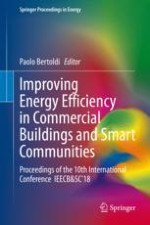These proceedings present fourteen peer-reviewed papers from the 10th International Conference on Improving Energy Efficiency in Commercial Buildings and Smart Communities, which was held March 21-22, 2018 in Frankfurt, Germany. This biannual conference aims to promote and diffuse the concept of energy efficiency in new and existing commercial buildings and to enlarge the market for low consumption and sustainable non-residential buildings. It also covers smart and sustainable districts, communities and cities, since energy systems efficiency and renewable energies are often optimized at the district or municipal level. The 2018 conference focused on advanced and innovative technologies to improve the energy efficiency of commercial buildings, communities and cities as well as the policies and measures by governments at various levels to improve energy efficiency. A particular focus was on Energy Service Companies (ESCOs). The conference addresses energy policy makers at international, national, and local level; academics, researchers and energy efficiency experts; ESCOs, utilities, buildings energy and environmental managers; buildings engineers and architects; and equipment manufacturers and commercial property investors.
